Washington Deploys Proxies to Xinjiang to
Scuttle China's Giant Infrastructure Project
Mike Whitney
 A Uyghur separatist group that helped to topple the government of Bashar al Assad has declared its intention to return to Xinjiang in order to conduct military operations against the People’s Republic of China. The announcement suggests that Washington and its allies are preparing to open another front in a war that has already plunged large parts of eastern Europe and the Middle East into chaos. The announcement was mostly ignored by the western media, but analysts believe we may have entered a new phase in America’s struggle to preserve its waning hegemony, a phase in which the probability of a direct clash between the United States and China has increased dramatically. A Uyghur separatist group that helped to topple the government of Bashar al Assad has declared its intention to return to Xinjiang in order to conduct military operations against the People’s Republic of China. The announcement suggests that Washington and its allies are preparing to open another front in a war that has already plunged large parts of eastern Europe and the Middle East into chaos. The announcement was mostly ignored by the western media, but analysts believe we may have entered a new phase in America’s struggle to preserve its waning hegemony, a phase in which the probability of a direct clash between the United States and China has increased dramatically.
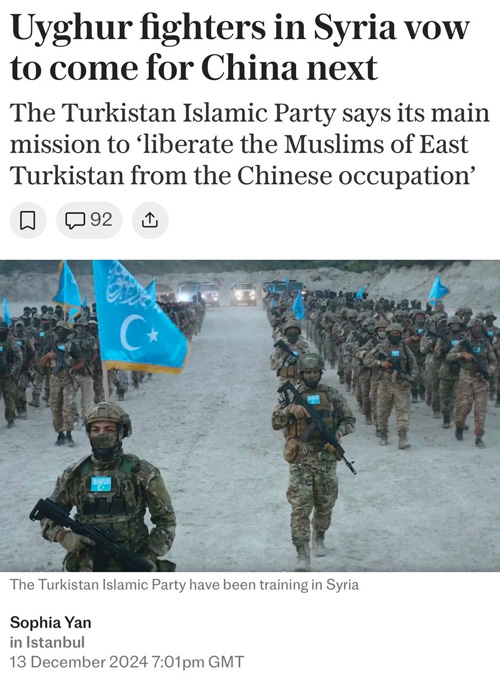
Also, if we assume that Washington’s sabotage of the Nordstream pipeline was designed to prevent the economic integration of Russia with the European Union, then we must assume that the same blueprint will be applied to China. Washington will use its Uyghur proxies to sever the critical arteries that link China to Europe, thus, blocking the rise of a free trade Superstate that would severely undermine US regional influence. This means we should expect a wave of asymmetrical attacks on vital infrastructure aimed at preventing the development of China’s signature Belt and Road Initiative. (More on this later) As always, US foreign policy is guided by the despotic credo called the Wolfowitz Doctrine which states the following:
Our first objective is to prevent the re-emergence of a new rival, either on the territory of the former Soviet Union or elsewhere, that poses a threat on the order of that posed formerly by the Soviet Union. This is a dominant consideration underlying the new regional defense strategy and requires that we endeavor to prevent any hostile power from dominating a region whose resources would, under consolidated control, be sufficient to generate global power.
Central Asia is the hill on which the US empire has chosen to die. Even so, a “cornered” Superpower that is armed to the teeth and led by ravenous warhawks can do considerable damage before it is brought to heel. That said, Washington’s focus on Central Asia is thoroughly understandable given the fact that the area is on-track to become the most populous and prosperous region in the world. Here’s how Zbigniew Brzezinski summed it up in The Grand Chessboard in 1997:
“For America, the chief geopolitical prize is Eurasia… (p.30)….. Eurasia is the globe’s largest continent and is geopolitically axial. A power that dominates Eurasia would control two of the world’s three most advanced and economically productive regions. ….About 75 per cent of the world’s people live in Eurasia, and most of the world’s physical wealth is there as well, both in its enterprises and underneath its soil. Eurasia accounts for 60 per cent of the world’s GNP and about three-fourths of the world’s known energy resources.” (p.31)
While Brzezinski helps us to grasp Eurasia’s importance vis a vis America’s ambition to maintain its grip on global power, political analyst Li Jingjing provides the details of why the US has chosen to use the Uyghurs as a means to destabilize Central Asia. Check out this riveting video that explains Xinjiang’s geostrategic importance and how it led to the creation of the “Uyghur genocide” hoax:
Li Jingjing—Do you know why the US wants to separate Xinjiang from the rest of China?
Because Xinjiang ‘s location is way too important geopolitically. Through Xinjiang, China can bring something to all of Eurasia that scares US politicians the most: Peace.
Let me explain why.
First, Xinjiang Uyghur Autonomous Region, located in northwest China, connects China with Central Asia. Xinjiang shares borders with eight countries: Mongolia, Russia, Kazakhstan, Kyrgyzstan, Tajikistan, Afghanistan, Pakistan and India. Xinjiang wasn’t just a key hub in the ancient Silk Road, it’s also a key gate for the current Belt and Road Initiative to expand westward. It will connect East Asia, Central Asia, West Asia and Europe.
This is the region that the US government and several western governments have been spending billions of dollars in the past decades to sponsor terrorism, wars and instabilities. The textbook divide and conquer strategy, because Eurasia is too big, and if they unite, they will be too strong. And that is a threat to the US maintaining its privileged position in the world, in other words, hegemony over the world.
However, China’s Belt and Road Initiative is bringing infrastructure and economic development to this region. China-Europe railways go through here, billions of dollars in trade is taking place at ports in Xinjiang and this economic development will raise the living standards of people across the region. And when people are better off, there will be no reason to participate in wars and terrorism.
So the US came up with a plan, they decided to support separatism and divide Xinjiang from China. In the 1990s, Graham E Fuller who served in the National Intelligence Council and the CIA, wrote a report called “The Xinjiang Problem”. In the report, he was teaching his fellow politicians and scholars, how to play the “Uyghur card” to stoke separatism among Uyghurs to destabilize and contain China. According to retired Lt. Colonel Lawrence B Wilkerson, who served as chief of staff under Secretary of State Colin Powell.
“Here is what we decided for Afghanistan. We were in Afghanistan as we were in post WW2 Germany, for 50 years. It has nothing to do with Kabul and state building, nothing to do with fighting the Taliban, or proving we can reconcile with the Taliban, and nothing to do with fighting any terrorist group. Because it is the only hard power the US has that sits proximate to the Belt and Road Initiative of China that runs across Central Asia. If we had to impact that with military power, we are in a position to do so in Afghanistan.
And the second reason we’re there is because we are cheek and jowl with the potentially most unstable nuclear stockpile on the face of the earth, in Pakistan. We want to be able to leap on that stockpile and stabilize it if necessary.
And the third reason we’re there is because there are 20 million Uyghurs. And if the CIA has to mount an operation using those Uyghurs, as Erdogan has done in Syria against Assad,there are 20,000 of them in Idlib in Syria right now, (That’s why the Chinese might be deploying military forces to Syria in the very near future to take care of those Uyghurs that Erdogan invited in.) Well, the CIA would want to destabilize China, and that would be the best way to do it to foment unrest and to join with those Uyghurs in pushing the Han Chinese in Beijing from internal places rather than external.”
Unfortunately for the US, their plan to separate China is failing. All 56 ethnic groups in China love and support each other, we united and hold on to each other like pomegranate seeds. And we will unite with the rest of the world to build a community with a shared future for all mankind. How the CIA Plans to Destabilize Central Asia by Playing the Uyghur Card, Li Jingjing @Jingjing_Li

Bottom line: The Uighur genocide is a human rights hoax that has been concocted in order to justify future hostilities against the PCR. In a recent article, editor Ron Unz exposed this sham and said this:
For several years our government and our mainstream media have heavily promoted claims of a Chinese genocide of the Uyghurs of Xinjiang, supposedly drawing upon secretive intelligence sources that I found very dubious. After watching those four hours of personal travelog footage, I consider those incendiary claims as totally preposterous as anything I’ve ever heard.Propaganda-Hoaxes vs. Chinese Reality, Ron Unz, Unz Review
Here’s more from Unz:
Top officials of the…. Trump Administration….(declared) that China was committing “genocide” against its Muslim Uyghur population of Xinjiang province, with the New York Times and our other leading media outlets endorsing and heavily amplifying those explosive accusations….. I regularly ridiculed those accusations, emphasizing that they seemed based upon no solid evidence and greatly reminded me of the false claims of Saddam’s WMDs that that been used to launch our ill-fated Iraq War….. What made these accusations about Xinjiang seem so totally absurd was that the huge province was completely open to both Chinese and foreign tourists, who regularly traveled there in large numbers, attracted by its scenic vistas and interesting Muslim Turkic culture. The notion that China was committing a “genocide” in a region constantly crisscrossed by tourists seemed like the most mindless sort of dishonest propaganda, aimed at the gullible and the dim-witted. Propaganda-Hoaxes vs. Chinese Reality, Unz Review
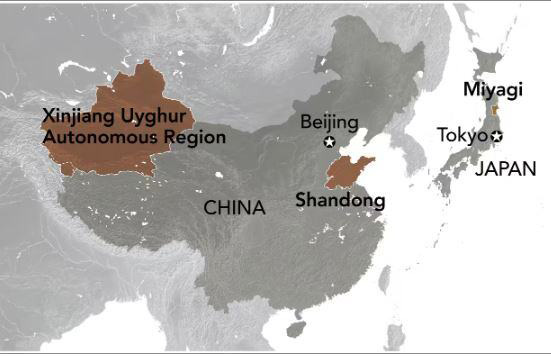
Unz’s view of the Uighur genocide is further reinforced by the group’s suspicious relationship to the CIA which suggests that the militants have been groomed for carrying out Washington’s geopolitical agenda. Check out this excerpt from an article at Global Research:
The Turkistan Islamic Party (TIC), a terrorist organization, was founded by Uyghur jihadists in 1988, just as separatist uprisings were breaking out in Xinjiang province, north-western China. The Turkistan Islamic Party, previously known as the East Turkestan Islamic Movement, received CIA sponsorship from its early existence.
In contradictory fashion, the Turkistan Islamic Party, which is based largely in north-western Pakistan, is deemed a terrorist organization by the United States, along with other major countries like Russia, and of course China and its neighbor Pakistan.
By 2001, militant Uyghurs were preparing for guerrilla warfare in the same camps situated in Afghanistan where the CIA and ISI, Pakistan’s intelligence service, had once provided training to Mujahideen extremists – in order to hamper Soviet troops embedded in Afghanistan 40 years ago. Between 1990 and 2001, the Turkistan Islamic Party perpetrated over 200 terrorist acts, including blowing up vehicles, market places and assassinating Chinese government officials….
High profile Uyghur separatists, like the Xinjiang-born Anwar Yusuf Turani, founder of the East Turkestan Government in exile, is himself living in the state of Virginia, on America’s east coast. Turani has been a willing tool in Washington’s power game with China; in June 1999, he met with president Bill Clinton and asked him to back political movements seeking independence for Xinjiang; and Turani later enjoyed dialogue with Clinton’s successor, George W. Bush, who promised to support the “fundamental human rights” of “Uyghurs and others living in China”….
Further prominent Uyghur exiles living in America have called for Xinjiang’s independence from China, such as Rebiya Kadeer, a five-time Nobel Peace Prize nominee, born in Xinjiang, and who also resides in the US state of Virginia.
For 11 years until November 2017, she was the leader of the World Uyghur Congress (WUC), headquartered in Munich, and which is partly funded by the National Endowment For Democracy (NED). The NED, partially subsidised by the United States Congress, has a long history of “soft power” interference in sovereign states around the world: China, Nicaragua, the Ukraine, and so on.
The World Uyghur Congress was established in April 2004 by Erkin Alptekin, a former adviser to the CIA.
Seventy Years of U.S. Destabilisation in China. U.S. Sponsored Uyghur Insurgency in Xinjiang, Global Research
So, a number of Uyghur separatists are “living in Virginia” (as guests of the CIA?) and we are expected to believe that Washington’s only interest is human rights?
Nonsense. The US is obviously arming, training and funding another vicious terrorist organization it intends to use to inflict a “strategic defeat” on China, the same as it is doing to Russia in Ukraine.
This is from an article at the Asia Times:
The rapid collapse of the Syrian Arab Army in the face of the advance of Turkish-backed Hayat Tahrir al-Sham… has drawn attention to the foreign fighters within their ranks. First and foremost among those foreign fighters are the Uyghurs from China’s Xinjiang Uyghur Autonomous Region. They used to fight China as part of the East Turkestan Islamic Movement but rebranded as the Turkistan Islamic Party some years back.
Regardless of whichever name they go by, the… organization has a history of collaborating with terrorist groups such as Al Qaeda in support of the quest to carve out a Uyghur state from China. That’s why it was designated as a terrorist group by the UN Security Council….
Members of the group just released a video from Syria calling for militant jihad against China. Yang Xiaotong contributed a detailed Asia Times piece on this subject under the title “China has cause to be terrified of rebel-run Syria.” Two of the most important points are that the Turkistan Islamic Party is recruiting members from Central Asia and that it could reestablish itself in Afghanistan to carry out attacks against the China-Pakistan Economic Corridor.
The corridor is considered to be the Belt and Road Initiative’s flagship project, and for years it’s been the target of attacks by the Balochistan Liberation Army….
the Turkistan Islamic Party could re-establish itself in Afghanistan … it could attack the China-Pakistan Economic Corridor …. it can’t be ruled out that the Turkistan Islamic Party might opportunistically want to hit China’s soft spot…
Beyond attacking Pakistani-based Belt and Road projects, such opportunistic motivation could also find relevance in Central Asia…. There are Uyghur communities in Kazakhstan and in perennially unstable Kyrgyzstan from which the Turkistan Islamist Party could find recruits – whether to carry out attacks against Belt and Road projects there or in Pakistan….
Another factor for observers to keep in mind is the role of Ukraine’s GUR military intelligence agency. The Washington Post reported that GUR played a role in HTS’s blitz across Syria. …Nevertheless, the contemporary GUR is also a CIA project, as the Washington Post reported in late 2023.
The possibility thus arises of the CIA using GUR as a plausibly deniable proxy for managing or at least encouraging the Turkistan Islamist Party’s expansion to the geostrategic Central Asian region between Russia and China. Uyghur separatist threat could reach beyond China’s Xinjiang, Asia Times
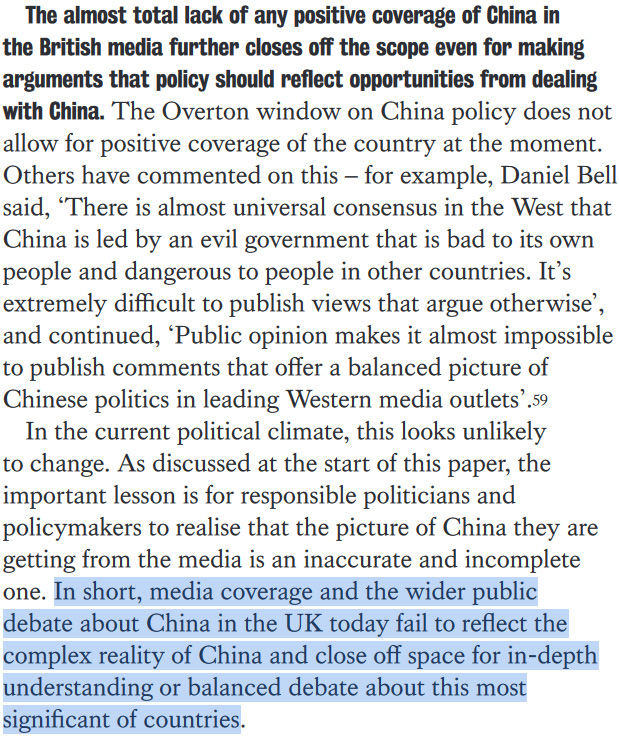
Of course, this is exactly what’s happening. The CIA is directly involved in hybrid war on China that will include the destruction of soft targets that are essential to complete Beijing’s massive infrastructure project. And what other choice does Washington have? Like Israel, Washington cannot preserve its privileged place in the world order by competing on a level playing field with China that has already overtaken the US in nearly every area of commerce, science and technology. The only way the US can maintain its tenuous grip on power is obliterating anything that threatens its global dominance and then convincing the world that it is just fighting for human rights. Here’s more from the Times of Israel:
Uighur militants have killed hundreds, if not thousands, in attacks inside China in a decades-long insurgency that initially targeted police and other symbols of Chinese authority but in recent years also included civilians. Extremists with knives killed 33 people at a train station in 2014. Abroad, they bombed the Chinese embassy in Kyrgyzstan in September last year; in 2014, they killed 25 people in an attack on a Thai shrine popular with Chinese tourists…..
China is just like the West, its officials say: the country is a victim of terror, and Uighur men are pulled by global jihadi ideology rather than driven by grievances at home.…. Seyit Tumturk, a Uighur activist in Turkey who often speaks to fighters in Syria… said it was impossible for Uighurs militants to liberate Xinjiang…. But he said Chinese President Xi Jinping’s ambitious project to develop railway lines, ports, and other infrastructure linking various regions to China makes Beijing vulnerable to militant attacks abroad.
The Islamic State took credit in June for kidnapping and killing two Chinese teachers in Pakistan’s Baluchistan province, which is a cornerstone of Beijing’s so-called Belt and Road infrastructure project….
Chinese officials and Western analysts alike say that the Uighurs’ experience in the Syrian jihadi melting pot will likely exacerbate violence against “soft” targets outside China. China’s foreign ministry called the Turkistan Islamic Party a security threat for the Middle East. Uighur militants in Syria look to Zionism as model for their homeland, Times of Israel
So—according to the Times of Israel—the Turkistan Islamic Party (TIP) is a ruthless group of bloodthirsty mercenaries who are motivated more by “global jihadi ideology rather than driven by grievances at home”. This is the organization the US has decided to back in its quest to destabilize China. And, notice that the authors of the Times article have drawn the same conclusion as the author of the Asia Times piece, that the Uyghurs MO will be to attack soft targets that will impact critical infrastructure in order to isolate China from the West while US military bases and Pacific alliances tighten the noose on China’s maritime trade.
And what targets will these Asian jihadis choose?
Some analysts like Andrew Korybko think that they will “carry out attacks against the China-Pakistan Economic Corridor….. (which) is considered to be the Belt and Road Initiative’s flagship project, Asia Times
But IMHO, I think Washington will attack critical nodes on the China-Europe Freight Train (CEFT) system. Keep in mind, the United States remains fully-committed to preventing the re-emergence of a rival in a region it considers vital to its national security (Central Asia) so, logically, we should expect that it will take extraordinary steps to separate China from Europe and, thus, lay the groundwork for economic strangulation. Here’s more from the The European Financial Review:
China’s Belt and Road Initiative (BRI) will officially be ten years old in 2023…. A crucial precursor to the BRI, and arguably its most prominent flagship project, the China-Europe Freight Train (CEFT) has already run through its first decade of 2011-21. With 82 routes currently connecting nearly 100 Chinese cities to around 200 cities across 24 European countries and more than a dozen Central, East, and Southeast Asian countries, the CEFT has formed a vast transcontinental freight system spanning both ends of Eurasia. While only 17 freight trains ran from China to Europe in the CEFT’s inaugural year of 2011, 60,000 trains cumulatively will have traversed the Eurasian landmass and its maritime margins by October 16, 2022 when the 20th Congress of the Chinese Communist Party (CCP) opens in Beijing.
As the CEFT enters its second decade poised for continued growth, a critical question looms: Is Russia’s war against Ukraine disrupting the CEFT, and how? On the one hand, the CEFT has depended heavily on Russia as both the most important terminus and through-corridor accounting for 37 percent of all CEFTs through 2021, leading Germany at 24.3 percent and Poland at 23.4 percent. On the other hand, the CEFT is anchored to a vast network of major and minor cities with grounded flexibility and resilience to weather the Ukraine storm.
Russia’s invasion of Ukraine in February 2022 threw a big geopolitical wrench into the CEFT-enabled Eurasian freight network….. The disruption appears major as the war is the biggest European conflict in eight decades, with severe geopolitical consequences…… Some disruption might arise…. as European companies avoid using the Russian Railway, fearing economic sanctions….
As the war in Ukraine keeps geopolitical tensions high, the extensive city-based CEFT network has acquired sufficient resilience from its continued expansion, improved infrastructure, and operational adaptability. These qualities may ensure the CEFT’s sustainability as a Eurasia-wide freight system. Eurasia’s Freight Infrastructure vs. Russia’s War in Ukraine, Chicago Council on Global Affairs
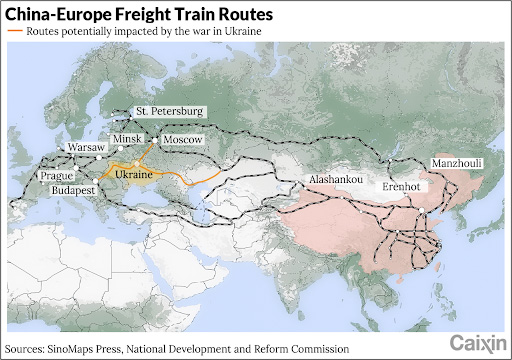
While economic sanctions on Russia have reduced freight traffic along the northern route by roughly 50 percent, the makeshift blockade in the Red Sea by the Houthis has dramatically impacted shipping through the Suez Canal. These growing threats to global security have shifted traffic to the Trans-Caspian International Transport Route (TITR)—which is a trade route from the Black Sea and the Caucasus to the Central Asian steppe. This so called Middle Corridor which ” follows the route of the ancient Silk Road” offers a viable alternative to the northern route but also faces its own security and infrastructure challenges.
Regrettably, we think US foreign policy strategists will focus on this Middle Corridor as a prime chokepoint for disrupting China’s freight service to Europe. Once again, the US cannot prevail in its war against China unless it is able to weaken the country via sanctions, isolation and persistent proxy warfare. Washington is positioning itself to either block or sabotage China’s trade-flows to Europe just like it sabotaged the flow of Russian gas to Europe. We believe that Uyghur jihadists will be used to help conduct these operations.
We also think that Washington will use any overreaction by Beijing as an excuse to deploy the U.S. Navy to block energy shipments to China, thereby preventing the country from accessing the resources it needs to heat its homes and fuel its industries. China imports over 70 percent of its oil which makes it vulnerable to hostile interdiction.
The US used this same strategy against Japan just months before the attack on Pearl Harbor, so it fully understands the implications of its actions.
Bottom line: Western elites have already decided that they will do ‘whatever it takes’ to preserve America’s global primacy. And, if that means nuclear war, then so be it.
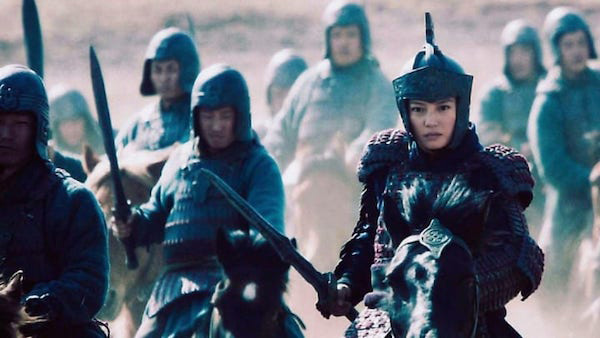

Mike Whitney writes on politics and finances and lives in Washington state. He can be reached at [email protected]
www.unz.com
| 

